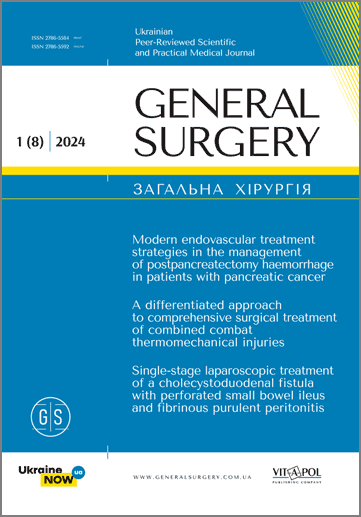Changes in the antibiotic-resistant properties of pathogenic microorganisms in patients with purulent-necrotic wounds against the background of type 2 diabetes when using a probiotic antiseptic
DOI:
https://doi.org/10.30978/GS-2024-1-43Keywords:
type 2 diabetes mellitus, antibiotics, antibiotic resistance, Bacillus subtilis, Klebsiella, PseudomonasAbstract
Antibiotic resistance remains a serious problem, leading to millions of deaths every year. The increasing prevalence of type 2 diabetes mellitus (T2DM) is contributing to the continued spread of this problem. Ukraine, like other countries, feels the consequences of this problem. Over the past ten years, the number of patients with T2DM has doubled, and diabetes is already the cause of disability and death for thousands of people. Complications of T2DM, such as diabetic foot syndrome, often require surgery and antibacterial therapy. New research shows the prospects of using probiotic antiseptics based on lactic acid bacteria of the genus Bacillus in the treatment of wounds, which may open new opportunities to combat this problem and improve treatment outcomes.
Objective — to analyse changes in the antibiotic‑resistant properties of pathogenic microorganisms in patients with purulent‑necrotic wounds in type 2 diabetes mellitus.
Materials and methods. The study, which was conducted at the Department of General Surgery No. 2 of Bogomolets National Medical University in Kyiv City Clinical Hospital No. 3, included 229 patients with purulent‑necrotic wounds and type II diabetes. A total of 229 patients were randomly divided into two groups, with one group receiving probiotic antiseptics and the other traditional chemical antiseptics, with subsequent analysis focusing on changes in antibiotic‑resistant properties against P. aeruginosa and K. pneumoniae. Antibiotic‑resistant properties were evaluated through microbiological examination, revealing significant changes in resistance patterns among patients treated with probiotic antiseptics compared to those using traditional chemical antiseptics, assessed using statistical methods including the Student’s t‑test and Wilcoxon W‑test.
Results. When the first subgroups were compared on the first day, there was no statistically significant difference in the levels of P. aeruginosa wound contamination (p=0.671). On the seventh day, there was a statistically significant difference between contamination levels (p<0.05) and the emergence of sensitivity to reserve antibiotics (p<0.05). On the 14th day, there was a statistically significant difference between contamination levels (p<0.05) and the emergence of sensitivity to reserve antibiotics (p<0.05).
Conclusions. Probiotic antiseptics have a statistically significant advantage over chemical antiseptics in terms of reducing contamination and emergence of antibiotic sensitivity in patients with purulent‑necrotic wounds in type 2 diabetes mellitus.
References
Al-Rubeaan K, Al Derwish M, Ouizi S, et al. Diabetic foot complications and their risk factors from a large retrospective cohort study. PLoS One. 2015;10(5):e0124446. http://doi.org/10.1371/journal.pone.0124446.
D’Accolti M, Soffritti I, Bini F, Mazziga E, Mazzacane S, Caselli E. Pathogen control in the built environment: a probiotic-based system as a remedy for the spread of antibiotic resistance. Microorganisms. 2022; 10(2):225. https://doi.org/10.3390/microorganisms10020225.
Demir S, Nawroth PP, Herzig S, Ekim Üstünel B. Emerging targets in type 2 diabetes and diabetic complications. Adv Sci (Weinh). 2021;8(18):e2100275. http://doi.org/10.1002/advs.202100275.
Diabetes [Internet]. World Health Organization. Available from: https://www.who.int/news-room/fact-sheets/detail/diabetes.
Lee SW, Park HJ, Park SH, Kim N, Hong S. Immunomodulatory effect of poly-γ-glutamic acid derived from Bacillus subtilis on natural killer dendritic cells. Biochem Biophys Res Commun. 2014;443(2):413-21. http://doi.org/10.1016/j.bbrc.2013.11.097.
Sukhum KV, Newcomer EP, Cass C, et al. Antibiotic-resistant organisms establish reservoirs in new hospital built environments and are related to patient blood infection isolates. Commun Med (Lond). 2022;2:62. http://doi.org/10.1038/s43856-022-00124-5.
Tang KWK, Millar BC, Moore JE. Antimicrobial Resistance (AMR). Br J Biomed Sci. 2023;80:11387. http://doi.org/10.3389/bjbs.2023.11387.
Tsukrovyj diabet 2 typu [Internet]. Available from: https://diabetes-site.phc.org.ua/tsukrovyj-diabet-2-typu/. Ukrainian.
Zhang P, Lu J, Jing Y, Tang S, Zhu D, Bi Y. Global epidemiology of diabetic foot ulceration: a systematic review and meta-analysis. Ann Med. 2017;49(2):106-16. http://doi.org/10.1080/07853890.2016.1231932.
Downloads
Published
How to Cite
Issue
Section
License
Copyright (c) 2024 Authors

This work is licensed under a Creative Commons Attribution-NoDerivatives 4.0 International License.






